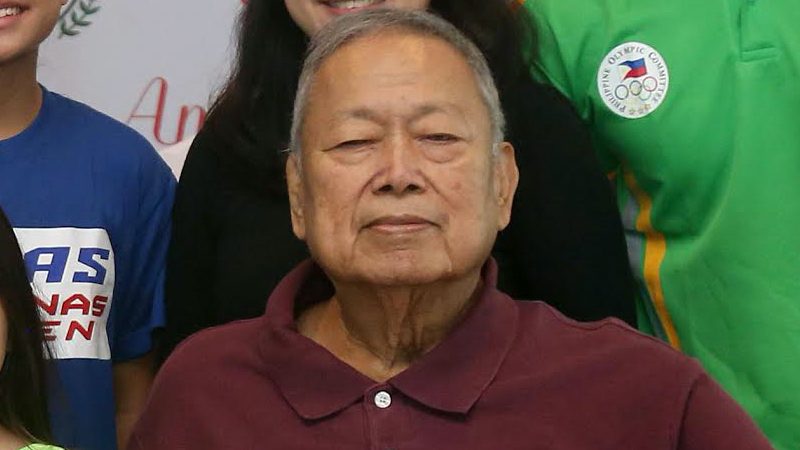SUMMARY
This is AI generated summarization, which may have errors. For context, always refer to the full article.

MANILA, Philippines – Former Philippine men’s basketball team coach Nicanor “Nic” Jorge died in his sleep on Saturday, June 13. He was 78.
He is survived by wife Marilyn, his children Nick, Veronica and Victor, and Monica, and grandsons Niccolo and Enzo.
Jorge, a grassroots basketball advocate, was the founder and president of Best Center. He also served as secretary-general of the Basketball Association of the Philippines (BAP), founding board member of the Samahang Basketbol ng PIlipinas (SBP), and the youngest coach the University of the Philippines (UP) Maroons.
Jorge’s wife, Marilyn, said the veteran mentor did not have any immediate health problems. “He just didn’t wake up,” she told Rappler in a phone interview.
Jorge was thrust into coaching as a player for the UP Maroons in the early 1960s. It was a path that he was never to leave.
“He used to say that basketball was his first love and I was his second,” said Jorge’s wife.
As a coach, Jorge believed physical conditioning and defense were important, along with a stern belief in fundamentals.
Above all, Jorge preached the full-court press, which he said to Rappler in a previous interview, that implementing it was an art. “You have to do it the right way to put pressure,” he said.
Gentle giant
Jorge was known to his friends as both a dreamer and a mover, proof to this was his founding in 1978 of the Basketball Efficiency and Scientific Training (Best) Center, a pioneering sports clinic that launched the careers of many basketball stars when there was no national youth development program for the sport yet.
The gentle giant Jorge did not stop producing sports stars until his death. Among the Best Center products who rose to become the biggest names in the sport are Benjie Paras, Jerry Codiñera, Boybits Victoria, Jun Limpot, Rey Evangelista, Patrick Fran, Paolo Mendoza, Chris Tiu, Joseph Yeo, Larry Fonacier, and Kiefer Ravena.
Jorge did not discriminate as he also rooted for women’s basketball development.
At the same time of his founding of the Best Center, Jorge also coached the Philippine team that saw action in the 1978 FIBA World Cup in Manila.
He also coached the Manhattan Shirthmakers and the Sunkist Juice Lovers in the early years of the Philippine Basketball Association (PBA).
Jorge served as the UP Maroons’ coach at the young age of 21.
Nemie Villegas, Jorge’s assistant coach in the Philippine team that played in the 1978 World Cup, said Jorge implemented a tough program.
“The players would run from Letran to CCP and back. After rest, we had stretching exercises which were not usually done. Practice was just as tough as the games,” said Villegas in a separate phone interview.
Though exposed to US and European coaching clinics, Jorge saw how the world’s top teams played in Manila.
“They were big men but their fundamentals were strong. And their shooting! Drazen Dalipagic of Yugoslavia and Oscar Schmidt of Brazil!,” he said, imitating the smooth release of the two deadshots.
Jorge would incorporate precise movement, smooth passing and deadly shooting by the world’s top teams in his Best Center.
Teaching kids
The Philippines formed two national teams for the 1978 event, which included the Asian Youth. It was acknowledged that the Youth squad was slightly better than the seniors but Jorge put the senior team, made up of tough players in the Manila Commercial and Industrial Athletic Association ( MICAA) into a tough program.
Villegas said Jorge emphasized stats in getting players. “We had statisticians during practice games, tuneups. And when we selected the team, he would show the statistics,” recalled Villegas.
Jorge told the national team they should fight in every game despite being outmatched. He was echoed by top newspaper columnist Teodoro Valencia, who helped raised funds for the team.
“I want to see you playing as if the score did not matter,” Villegas recalled Valencia saying.
But as Padim Israel recalled in an old interview with Rappler, the opponents were just too big and wore them out.
Against Yugoslavia, the eventual world champions, the Philippines battled them in a high scoring game but their foes fell back on precise passing, feeding their shooters or lobbing the ball to star center Kresimir Cosic.
Jorge and Villegas learned valuable lessons from the 1978 world championship. Jorge became a PBA coach and Villegas steered Letran to the 1979 NCAA title and the intercollegiate crown. Both returned to their first loves: teaching kids.
Silent worker
Unknown to many, Jorge was also one of the silent workers who strove to form what was then known as the “basketball superbody” that aimed to replace the dysfunctional Basketball Association of the Philippines (BAP), in which he served as secretary-general.
Along with then PBA commissioner Jun Bernardino and former Asian Basketball Confederation (ABC) secretary-general Mauricio “Moying” Martelino, it was the trio which convinced tycoon Manny V. Pangilinan to take the helm of the country’s basketball program.
It was not an easy route, but Pangilinan’s team managed to gain the FIBA approval that led to the formation of the Samahang Basketbol ng Pilipinas (SBP).
Jorge briefly served at the SBP but went back to what he loved most, training and developing the youth in basketball and then lately in volleyball.
His body will be cremated Sunday. – Rappler.com
Add a comment
How does this make you feel?
There are no comments yet. Add your comment to start the conversation.